Spider-Man: Miles Morales PC GPU Testing — Upscaling for Everyone
Pick from a smorgasbord of DLSS 2, DLSS3, FSR 2.1, and XeSS
Spider-Man: Miles Morales officially lands on PC today, and we've taken the time to run a bunch of benchmarks on some of the best graphics cards to see how it runs. It's the same great game that came out on the PlayStation 4 and 5 two years ago, now on your PC! It also has enhanced visuals, including more significant ray tracing effects (reflections and shadows) plus the full suite of upscaling technologies.
We're using a preview version provided by Sony, but we're told it should be very close to the retail release. All our testing used the latest drivers: AMD 22.11.1, Intel 31.0.101.3802, and Nvidia 526.98. As a nice change of pace, these are all "Game Ready" for Spider-Man: Miles Morales.

The official system requirements and recommendations information from Sony is quite extensive, covering the gamut from minimum requirements for 720p at 30 fps and topping out at ultimate ray tracing settings for 4K and 60 fps with maxed out settings.
The base recommendation lists a GTX 950 "or AMD equivalent" — roughly a R7 370, though driver support for pre-RX GPUs has been discontinued. Let's call it an RX 460 as a minimum GPU. It might run on less than that, but we wouldn't count on a fluid experience. The minimum CPU lists a Core i3-4160 or AMD equivalent, and again you can probably run the game on older AMD FX-series CPUs if you want.
The remaining requirements list 8GB or more RAM, Windows 10 64-bit, and 75GB of storage (SSD recommended). If you want to run at maxed out settings, Sony lists an RTX 3080 or RX 6950 XT and a Core i7-12700K or Ryzen 9 5900X. It doesn't explicitly say that upscaling is required to hit 60 fps... but upscaling is required as we'll see shortly.

Spider-Man: Miles Morales PC Test Hardware
We didn't go back too far on our hardware testing, sticking with more recent graphics cards from the GTX 16-series and newer, RX 6000-series for AMD, and a couple of Intel Arc GPUs for good measure. Our CPU is a Core i9-12900K, 32GB of DDR4-3600 memory, and a large 2TB Crucial P5 Plus SSD. We're running Windows 11 22H2.
Our GPU test suite consists of the latest GeForce RTX 4090 and GeForce RTX 4080 from Nvidia, along with previous generation RTX 3090, RTX 3080, RTX 3070, RTX 3060, RTX 2060, GTX 1660 Super, and GTX 1650 Super. From AMD, we tested the Radeon RX 6950 XT, RX 6800 XT, RX 6700 XT, RX 6600 XT, and RX 6500 XT. Finally, from Intel we tested the Arc A770 Limited Edition and the Arc A380 from Gunnir.
Those graphics cards don't include every possible option, but it's a representative view of what's currently available and you should be able to fill in the gaps with missing cards. For example, the RX 6800 lands roughly between the 6800 XT and 6700 XT, probably closer to the former than the latter. Check our full GPU benchmarks hierarchy for more details on how the other graphics cards stack up.

For testing, we're using our normal approach of running at 1080p medium and ultra (very high in this case), plus 1440p and 4K at the highest preset (very high). Because Spider-Man: Miles Morales supports ray tracing, we also tested those same four settings with "medium" and maxed out DXR (DirectX Raytracing) settings. But we didn't stop there!
As mentioned already, Spider-Man: Miles Morales includes support for all the latest and greatest upscaling technologies: DLSS, FSR, XeSS, and the game's own IGTI (Insomnia Games Temporal Injection). Let's be frank: IGTI looks the worst, by far, in our opinion. Since all of the others should deliver superior image quality, we confined our testing to the best option for each GPU — though we tested both DLSS 2 and DLSS 3 (Frame Generation) on the RTX 40-series.
If you're running an older and/or slower GPU that can't get to playable levels of performance using FSR 2.1, which is the most general upscaling solution, feel free to give IGTI a shot. It's more like FSR 1.0 in terms of quality, but it's also very lightweight and so it should help more on low-end integrated graphics solutions. And with that out of the way, let's check the performance.

Spider-Man: Miles Morales PC 1080p Medium Performance
We have four charts for each of the core settings: standard rendering (no ray tracing), standard rendering with upscaling, ray traced performance, and ray tracing with upscaling. We'll start each section with the rasterization performance and then hit the ray tracing performance.

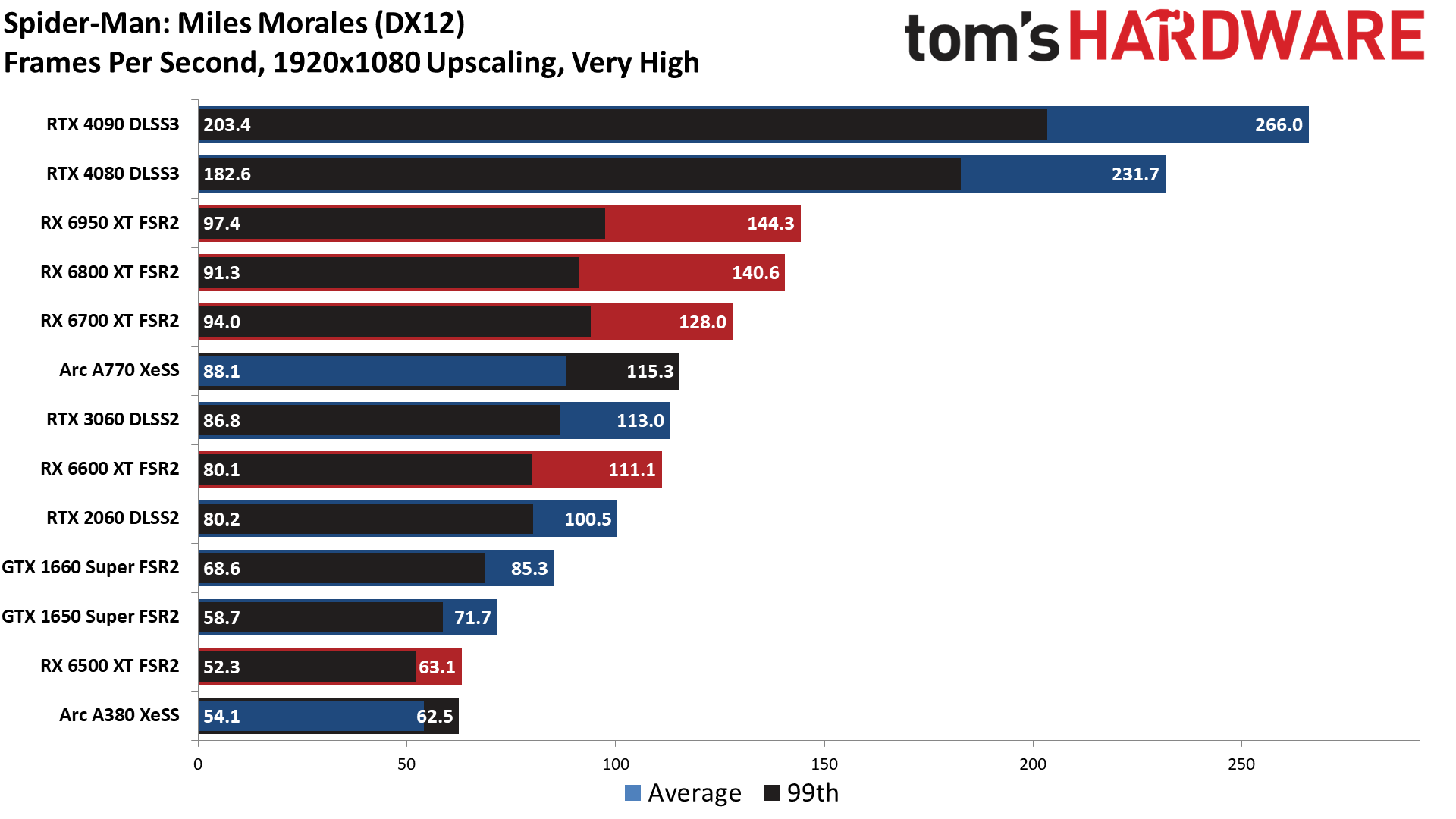
At 1080p medium, the lowest settings we took the time to test, all of the graphics cards turn in playable results. That's not too surprising, though the A380 and 6500 XT fall short of 60 fps — the only two cards we tested that failed to reach that mark. Also note that maximum performance tops out at around 150 fps on the three fastest Nvidia cards.
Turning on normal upscaling modes won't break the ~150 fps mark, as we're CPU limited. DLSS 3 on the other hand uses Frame Generation that creates extra frames without the CPU being involved. The result: up to 266 fps on the RTX 4090, and 232 fps on the 4080. (We didn't bother testing DLSS 2 modes on the faster Nvidia cards due to time constraints and the ~150 fps limit.)


Turning on "medium" levels of ray tracing drops the maximum FPS to around 120. That makes sense as the CPU gets involved with ray tracing — it has to generate the BVH (Bounding Volume Hierarchy) that the GPUs then use for RT effects. Ray tracing also tanks performance quite a bit on some of the slower GPUs, like AMD's RX 6500 XT. 4GB and eight AMD Ray Accelerators just isn't enough to do much in the way of DXR calculations.
Also note that the A380 performance got worse with XeSS. That's probably because the algorithm is more optimized to run on the A750 and above, where it has a much higher level of compute available. Ironically, it might actually do better with FSR 2.1.
For the other graphics cards, upscaling helps a little but not much... except for DLSS 3. DLSS 3 vaults past the CPU limit and provides nearly 200 fps on the 4080 and 217 fps on the 4090. That's a 93% improvement for the 4090 and a 72% boost to the 4080. Other cards like the 6950 XT and 3080/3090 only see single digit percentage gains.
Get Tom's Hardware's best news and in-depth reviews, straight to your inbox.

Spider-Man: Miles Morales PC 1080p Very High Performance
We'll just lump all four charts into one group on the remaining tested settings, as hopefully the pattern of testing should be clear now.




Maxed out settings, even without ray tracing, proves to be about the limit of what you can expect from the lower spec cards. The Arc A380 and RX 6500 XT clear 30 fps, barely, and not much more. Upscaling on the other hand helps more this time, suggesting that the per-pixel complexity of FSR and XeSS is quite a bit lower than the Very High setting — which wasn't true at medium settings.
The fastest graphics cards are still bumping into CPU limits, and note how Intel's A770 continues to perform quite well for a mainstream GPU — it's priced higher than the RX 6600 XT but about the same as the RTX 3060. Upscaling puts all three GPUs on relatively equal footing, though. (And the 3070 DLSS2 result might be a bad run, or else Quality mode DLSS just doesn't help much on any of the Nvidia cards.)
DLSS 3 Frame Generation continues to make a huge difference, and it's not just a placebo in my experience. On a 144 Hz monitor, it may not matter too much, but the boost to minimum fps does seem to help. Of course, the base performance (from the CPU) is still at 100 fps or so, which means latency is low enough as to not be particularly noticeable.

Spider-Man: Miles Morales PC 1440p Very High Performance




1440p pushes well beyond the capabilities of the slowest GPUs, which is expected. The 1650 Super almost hits 30 fps, but FSR2 Quality mode doesn't help it at all. A lighter upscaling algorithm like IGTI or FSR1 would help it get to playable levels, but most people running budget GPUs probably are fine at 1080p to begin with.
As the demands on the GPU increase, we finally start to see some separation among the fastest GPUs. Interestingly, the 4080 still beats the 4090, which is probably just margin of error. The 3090 also beats all AMD cards, with the 3080 coming in just ahead of the 6800 XT as well. Intel's A770 falls right behind the 6700 XT and comes in quite a bit ahead of the 3060 again.
With DXR enabled, at native resolution everything drops below 100 fps now. The 4090 leads the 3090 by 38%, the 3080 ties the 6950 XT, and the A770 ties the RTX 3070. That last is proof yet again that Intel's RTU hardware is indeed quite capable.
With upscaling, I tested the 4090 and 4080 with and without Frame Generation this time (DLSS3 and DLSS2 modes). Both are mostly CPU limited to around 100 fps with DLSS2, while the 4090 gets much larger gains from Frame Generation. That's a bit interesting, since the OFA is fixed function hardware, so probably something else is at play.
At the bottom of the DXR charts, the 6600 XT and RTX 2060 both fall below 30 fps now, with or without upscaling. Probably Performance mode upscaling would get them to playable levels if you want to take that route.

Spider-Man: Miles Morales PC 4K Very High Performance


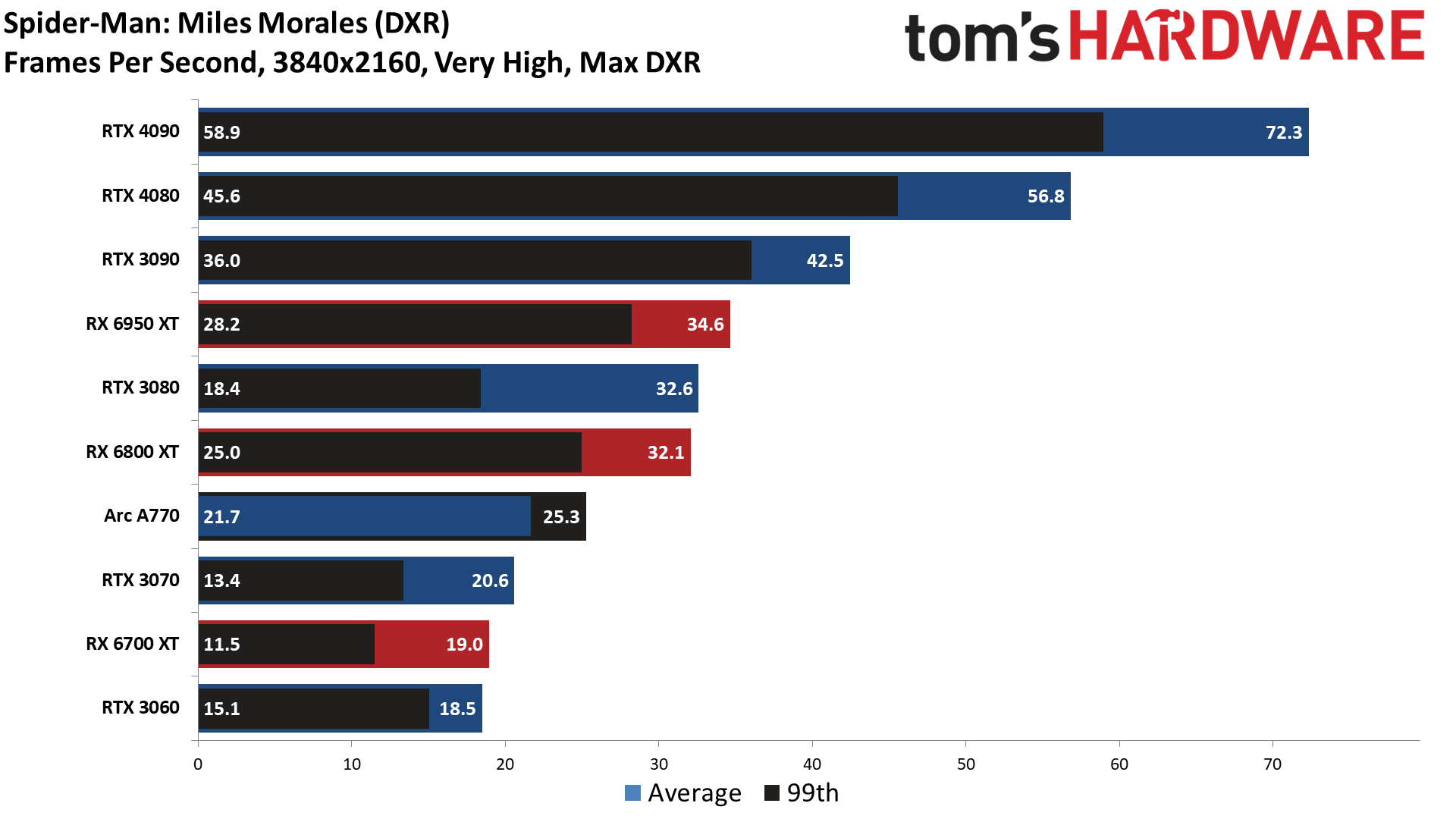
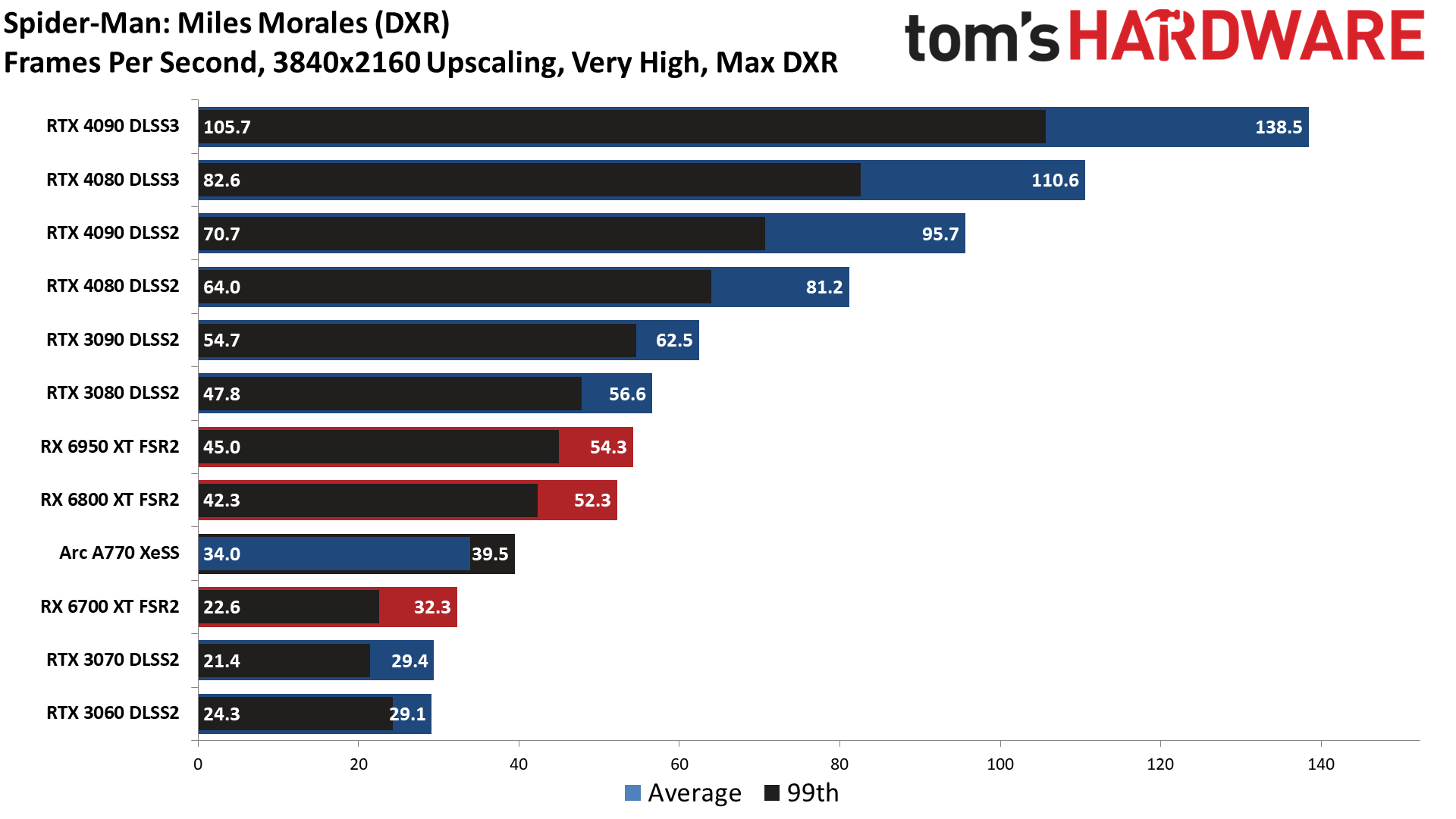
Wrapping up the testing with our 4K maximum quality results, the 4090 and 4080 continue to deliver over 100 fps without ray tracing, and again DLSS3 provides a huge jump in framerates. The RX 6600 XT and RTX 2060 just barely clear 30 fps with upscaling, and the RX 6800 XT still clears 60 fps at native resolution. With upscaling, the RX 6700 XT, RTX 3070, and Arc A770 also join the 60 fps party.
This is why upscaling technologies are here to stay. We're only testing with the highest quality upscaling modes, and we're already seeing about a 30% or higher boost in performance. At 4K, using Balanced or even Performance mode upscaling becomes viable, and those should make a lot more GPUs capable of "4K gaming."
Of course ray tracing at maximum settings and 4K is another matter. The 4090 is the only card to clear 60 fps without upscaling, while the 4080 falls just a few FPS short. RX 6800 XT and RTX 3080 meanwhile are just barely staying above 30 fps, with minimums well below that mark in the case of the 3080 10GB card. We noticed that 4K and maximum DXR settings looks like it really wants more than 10GB VRAM — the 3060 12GB card for example has minimum FPS that's much closer to the average.
With Quality mode upscaling, only the RTX 3090 and above clear 60 fps. The 3080, 6950 XT, and 6800 XT would need to use Balanced or Performance upscaling to clear 60. Given the Arc A770 only averaged 58 fps at 1080p without upscaling, even 4x upscaling won't get it above 60 fps at 4K and maxed out settings.
Spider-Man: Miles Morales PC Settings





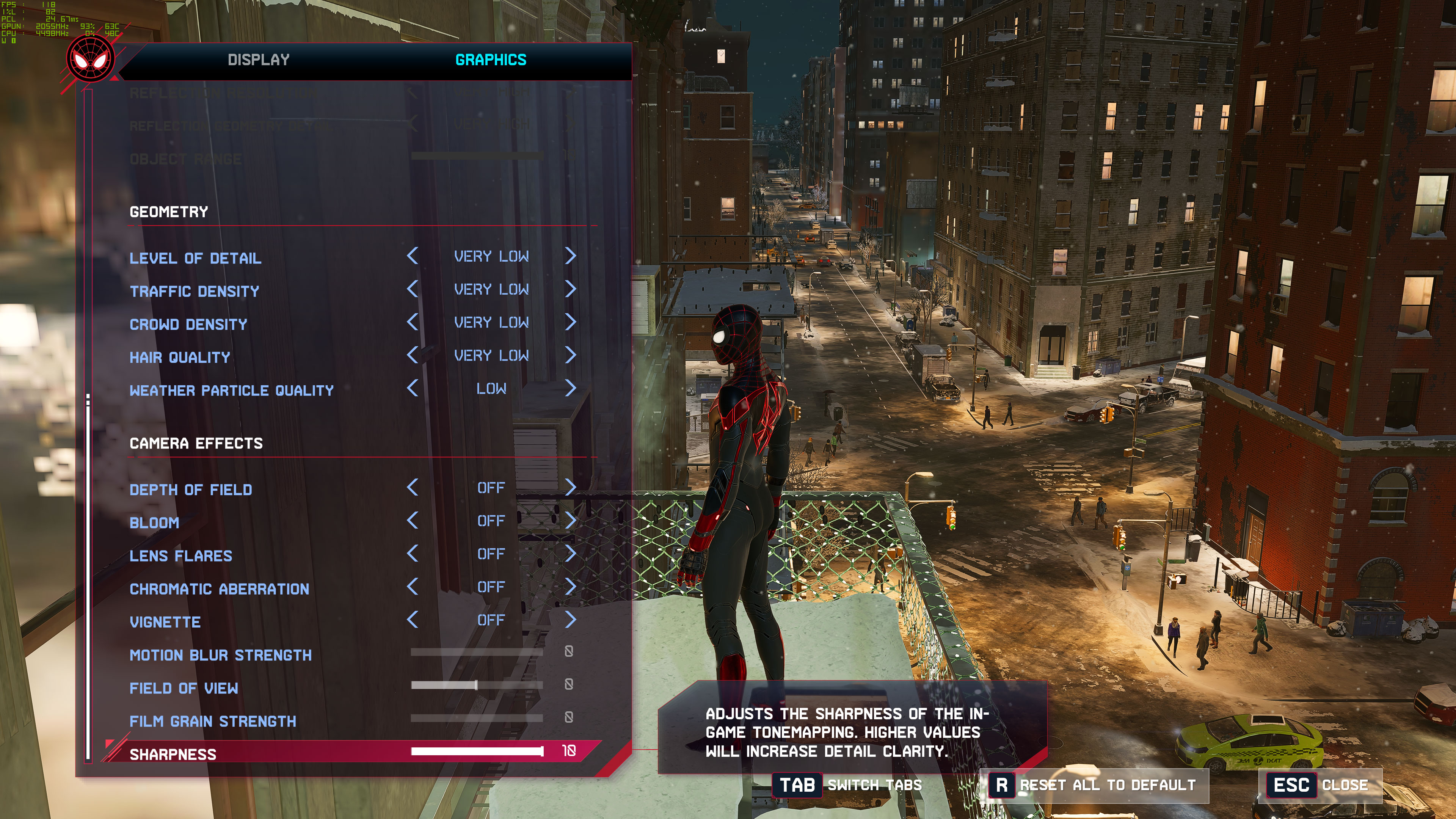
Spider-Man: Miles Morales provides PC users plenty of settings to tweak as needed. Our testing focused on the medium and very high presets, plus ray tracing and upscaling. But beyond those and resolution, you have 24 individual graphics settings you can adjust. We should note that, as always, we dislike the Chromatic Aberration effect that blurs the outer edges of the display and recommend disabling it. The Vignette effect meanwhile doesn't appear to do anything (normally it's supposed to darken the outer edges).
We didn't have time to run a full suite of tests with all the various settings, but we grabbed screenshots on an RTX 3090 Ti at 4K native with the various settings at their minimum values, which you can see in the gallery below. Instantaneous FPS is in the corner, which isn't quite as useful as a lengthier benchmark but it can at least give a ballpark indication of performance.



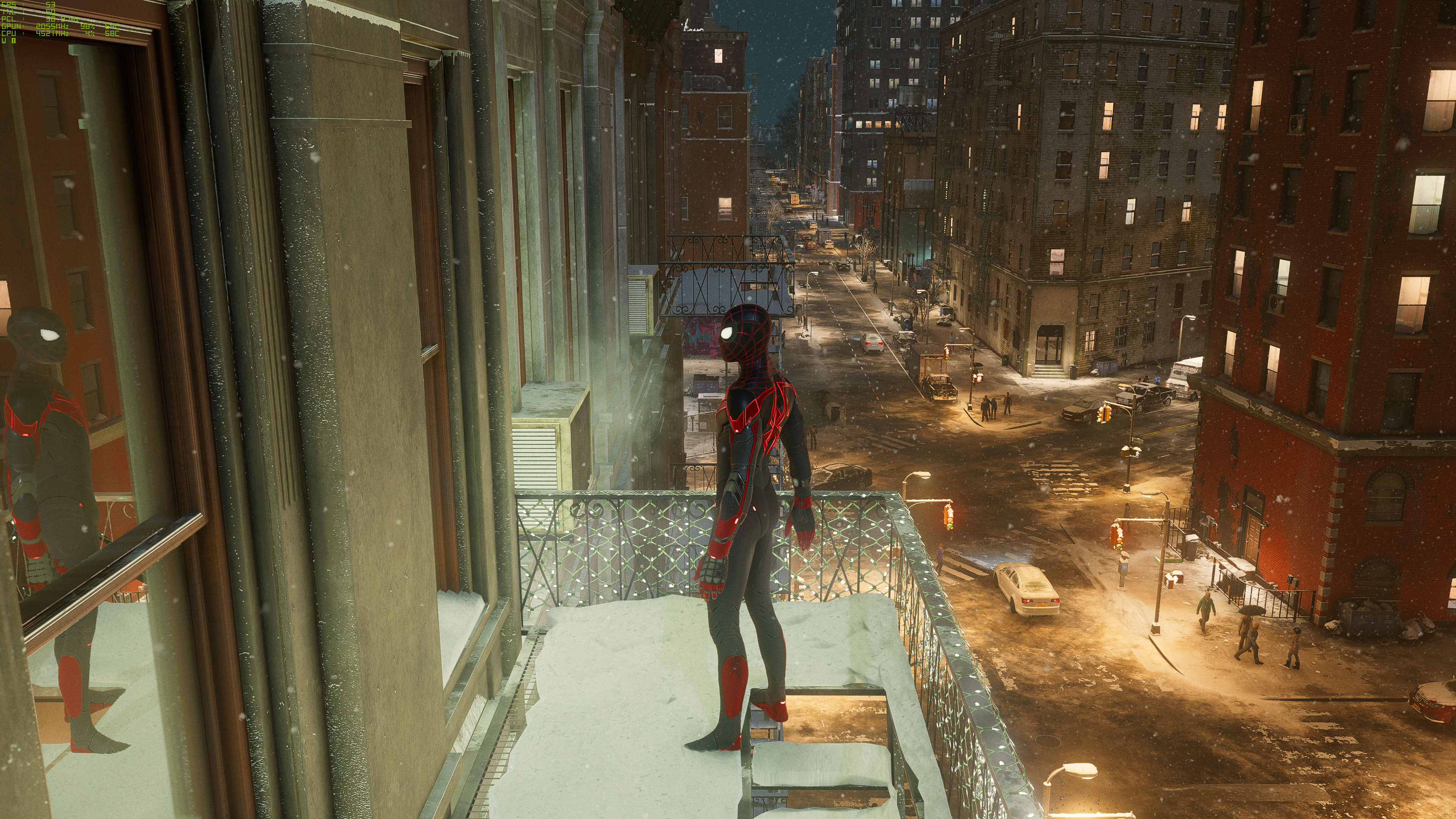













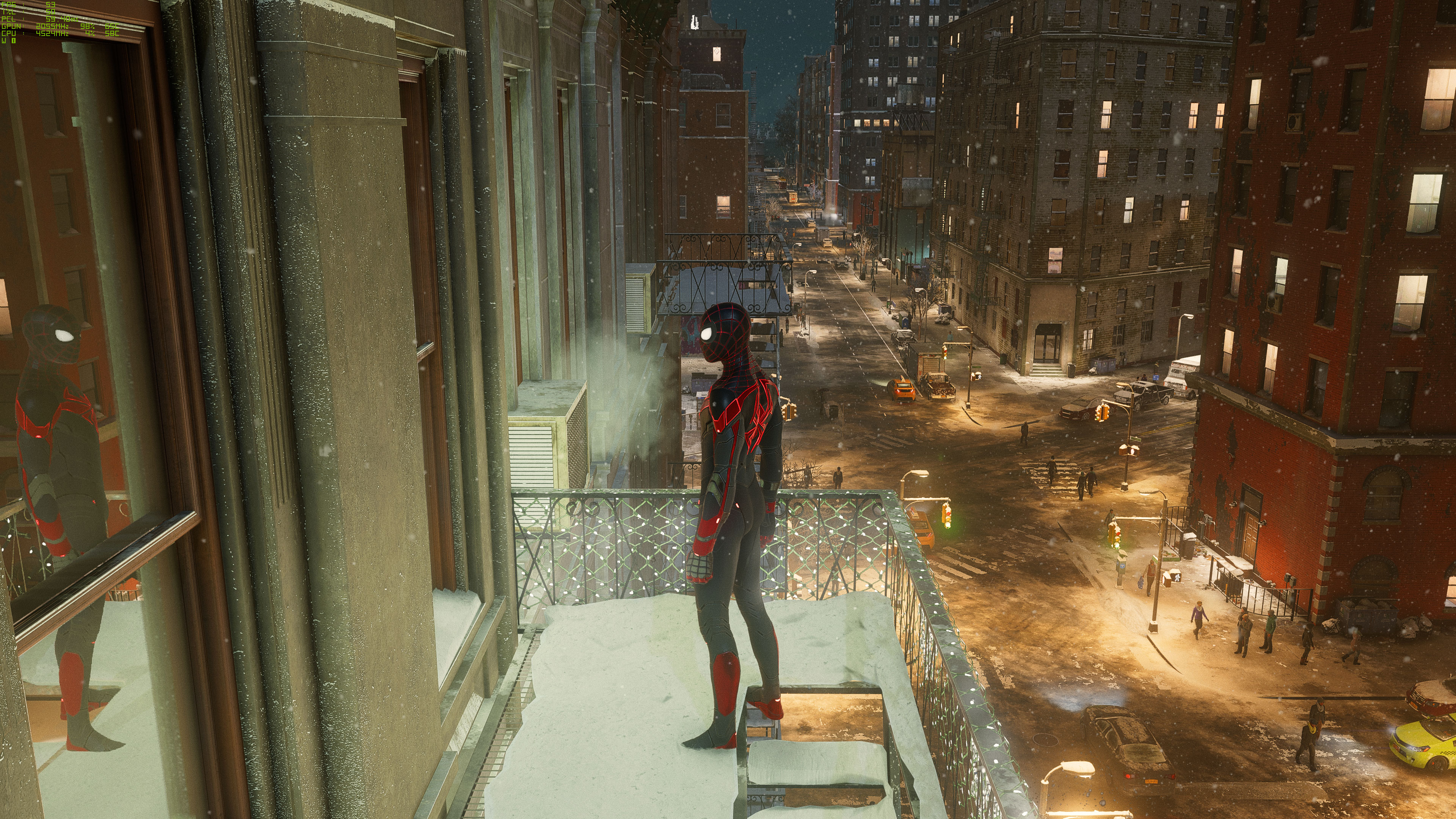
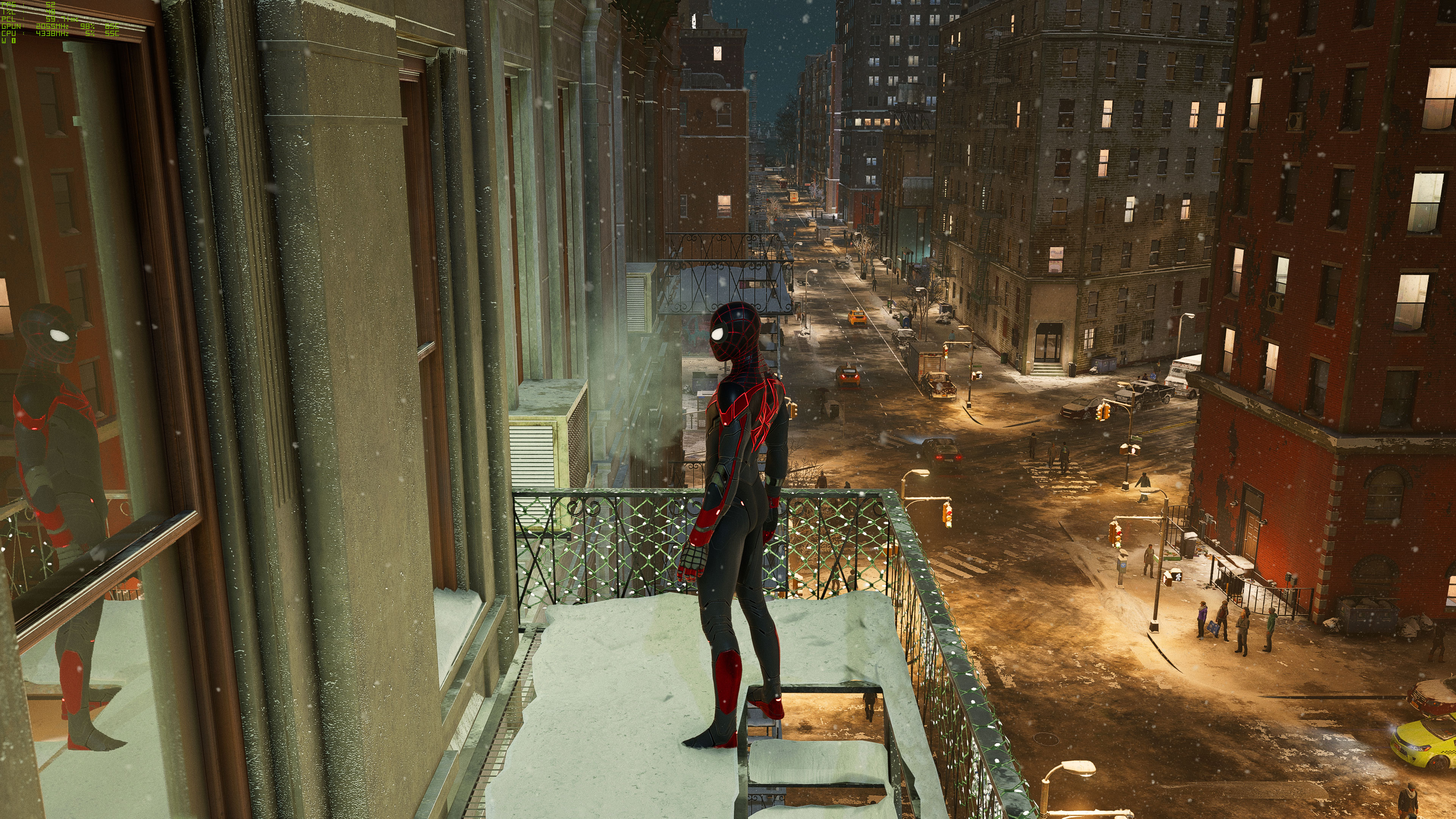



The short summary is that ray tracing should be the first thing to go if you're trying to improve performance. Sorry Nvidia, but the visual gains in a lot of the game aren't that noticeable. If you're standing next to a building with reflective windows, yes, it can matter. Swinging through the snow-covered city in most cases won't look that different.
Mind you, I do like the reflections. Seeing Spidey standing in a window adds something. You can turn down the reflection resolution and geometry detail to gain back some performance. The ray-traced shadows on the other hand didn't make much of a difference in my experience and can be turned off.
Beyond ray tracing, none of the other individual settings have a major impact on performance. Most are less than 1–2 percent, and even things like shadows only improved performance maybe 5%. But the sum of the parts ends up greater, as going from maximum to minimum settings (not counting ray tracing) can provide about a 50% boost to your FPS.





Well, none of the other settings besides upscaling. Above you can see native with the four different upscaling algorithms, all running on the 3090 Ti: IGTI, DLSS 2, FSR 2.1, and XeSS. In order to tax the algorithms a bit more, and provide more of a performance boost, we ran each in Balanced mode (usually 3x upscaling, so taking ~2217x1247 resolution images and upscaling those to 3840x2160).
We actually captured performance for ten seconds on each to get a better idea of how they compare, so ignore the framerates shown in the upper-left in the screenshots. Native resolution ran at 48.3 FPS for the area in the scene. IGTI delivered the largest gain, running at 82.2 FPS. DLSS and FSR 2.1 were close behind at 79.1 FPS and 80.7 FPS, respectively — yes, for this particular scene, FSR 2.1 delivered slightly better performance than DLSS on the 3090 Ti. Finally, XeSS delivered the smallest gain with 73.8 FPS. That makes sense, as XeSS is a relatively complex algorithm and on non-Intel GPUs it has to run in DP4a mode.
As for image quality, IGTI does show the greatest loss of detail, especially on the wall textures to the left. The other three upscaling algorithms are all pretty comparable. In motion, DLSS might still have a slight advantage, but all of the modes can make the game fun faster — on the right hardware. Of course we don't have DLSS 3 image comparisons, as the extra Frame Generation content doesn't get properly captured in the usual fashion, but in playing the game I would personally enable the feature on any RTX 40-series card. After all, you paid for the option at the factory!
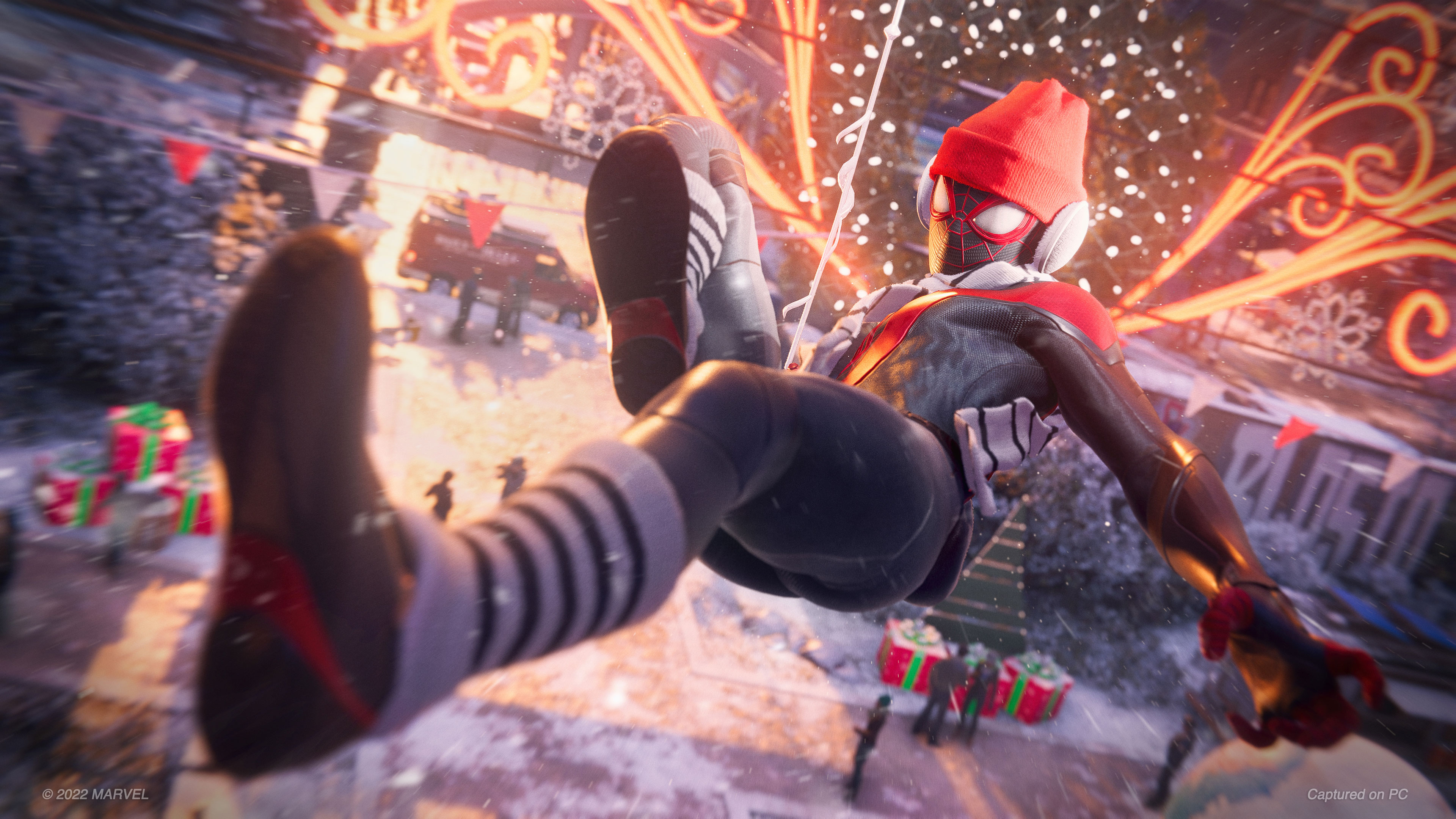
Final Thoughts
Spider-Man: Miles Morales is a great game that has only been on PlayStation for the past two years. If you haven't played it there — I haven't — the PC version ups the visual ante and runs great... on the right hardware.
We're impressed with the full suite of upscaling options that Sony (Insomniac Games) chose to include. It provides the best look at performance and image quality from the various upscaling modes, but more importantly it gives everyone the option to run whatever works best on their hardware. RTX owners will still likely use DLSS, Intel Arc users can run XeSS, and everyone else will have the option of FSR 2.1 for quality or IGTI for performance. Choice is a great thing to have!
Still, two years for the PC port is too long, Sony! There are millions of PC gamers that don't own a PlayStation console, and it's doubtful sales of games like Spider-Man: Miles Morales spurred console purchases much after the initial wave was over. Maybe try shortening that down to six months, or even three! Because there are plenty of PC users that would love to see more of the first-party PlayStation games on their platform of choice.

Jarred Walton is a senior editor at Tom's Hardware focusing on everything GPU. He has been working as a tech journalist since 2004, writing for AnandTech, Maximum PC, and PC Gamer. From the first S3 Virge '3D decelerators' to today's GPUs, Jarred keeps up with all the latest graphics trends and is the one to ask about game performance.
-
Zarax Excellent analysis Jarred, do you think it would be possible to do something similar with the new ultra RT setting in CP2077?Reply -
Roland Of Gilead Possible to use the screen enlargement/magnify option for the charts? My 49yr old eyes can't take squinting so much, my eyes feel like they'll burst :tearsofjoy:Reply
Good article Jarred. I like these game focused reviews. -
JarredWaltonGPU Reply
The RT-Overdrive you mean? (RT-Ultra has been out since the game first shipped.) I could do it. All of the GPUs are already tested in CP77, I just don't do DLSS/FSR with it. Did CP77 get XeSS as well, or just DLSS3 and FSR2.1? Guess I'll have to look.Zarax said:Excellent analysis Jarred, do you think it would be possible to do something similar with the new ultra RT setting in CP2077?
I'm planning to update the GPU testbed at some point (13900K), so I'll have to go about retesting everything once I make the change. Fun times! I will also rethink what games and settings I want to test with going forward.
Are you viewing on a smartphone or on a PC? On the PC, you can always right-click and then view the image, and then if you edit the URL you can remove the size to get the original 1920x1080 images. That's a bit of a pain, but if I add the option to show a full size image it overlaps the top-right corner and looks dumb. I can read the chats just fine on a PC, though... and can zoom in to get a bigger view if needed (slightly fuzzy), so I'm guessing you're on a small phone display. That generally results in a poor viewing experience for our charts, sadly.Roland Of Gilead said:Possible to use the screen enlargement/magnify option for the charts? My 49yr old eyes can't take squinting so much, my eyes feel like they'll burst :tearsofjoy:
Good article Jarred. I like these game focused reviews. -
Roland Of Gilead ReplyJarredWaltonGPU said:The RT-Overdrive you mean? (RT-Ultra has been out since the game first shipped.) I could do it. All of the GPUs are already tested in CP77, I just don't do DLSS/FSR with it. Did CP77 get XeSS as well, or just DLSS3 and FSR2.1? Guess I'll have to look.
I'm planning to update the GPU testbed at some point (13900K), so I'll have to go about retesting everything once I make the change. Fun times! I will also rethink what games and settings I want to test with going forward.
Are you viewing on a smartphone or on a PC? On the PC, you can always right-click and then view the image, and then if you edit the URL you can remove the size to get the original 1920x1080 images. That's a bit of a pain, but if I add the option to show a full size image it overlaps the top-right corner and looks dumb. I can read the chats just fine on a PC, though... and can zoom in to get a bigger view if needed (slightly fuzzy), so I'm guessing you're on a small phone display. That generally results in a poor viewing experience for our charts, sadly.
Was reading it on PC. Will trick around with it. Cheers -
evdjj3j "We didn't go back too far on our hardware testing"Reply
Is this part of low effort November?